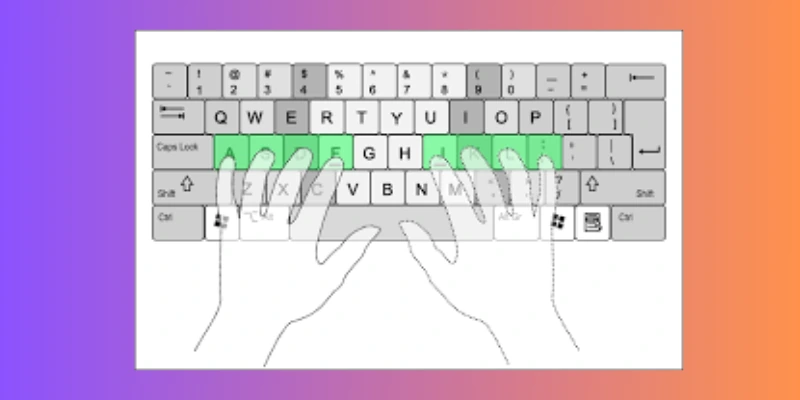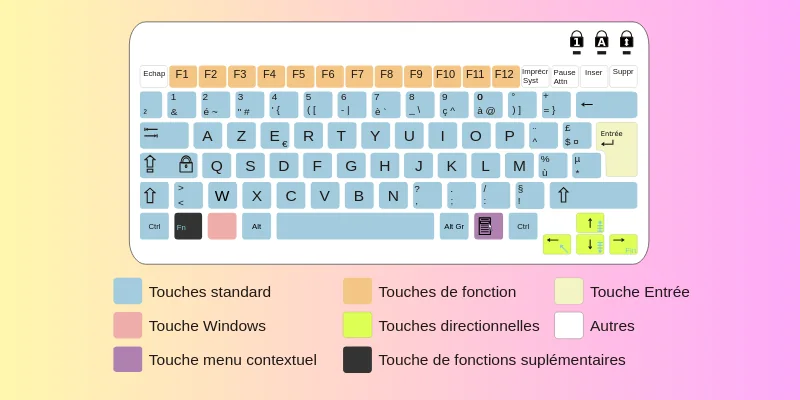Qwerty vs Azerty Layout guides your fingers
Published: 23 May 2025
In the digital age, the keyboard remains one of the most essential tools for human-computer interaction. From writing emails and coding to gaming and creative writing, our efficiency often hinges on how effectively we can type. Central to this experience is the keyboard layout, a design that may appear universal but varies significantly across regions and languages.
Two prominent layouts in use today are QWERTY vs AZERTY. While they share a historical lineage, they differ in purpose, regional usage, design, and functionality. This in-depth comparison will explore the origins, structural differences, usability, regional distribution, advantages, disadvantages, and suitability of each layout to help users understand which is best suited for their needs.
1. QWERTY Keyboard Layout
The QWERTY keyboard layout was designed in the 1870s by Christopher Latham Sholes, the inventor of the first successful typewriter. Its name comes from the first six letters in the top alphabetic row: Q-W-E-R-T-Y. Contrary to popular belief, QWERTY was not necessarily designed for speed or ergonomic efficiency but rather to prevent the jamming of mechanical typewriters. By separating commonly used letter pairings, the layout reduced the chance of mechanical arms clashing during rapid typing.
The QWERTY layout was popularized by the Remington No. 1 typewriter and quickly became the de facto standard in English-speaking countries. Over the decades, QWERTY’s dominance has continued due to hardware compatibility, software support, and user familiarity, making it the most widely used keyboard layout in the world today.

2. AZERTY Keyboard Layout
The AZERTY layout emerged as a variation of QWERTY to better accommodate the French language. It was developed in the late 19th century to provide easier access to accented characters and commonly used French letters and symbols. The name AZERTY comes from the top six alphabetical keys on the left: A-Z-E-R-T-Y.
Despite being a modified form of QWERTY, AZERTY underwent several changes to support French-specific needs. It is mainly used in France, Belgium, and some French-speaking countries in Africa. While France has had some layout standardization challenges, recent reforms have aimed to unify the layout and improve accessibility.

3. Key Layout Differences
Though QWERTY and AZERTY share many similarities, there are crucial differences in the placement of characters and accessibility of language-specific features.
1. Alphabet Arrangement
- QWERTY begins the top row with Q-W-E-R-T-Y.
- AZERTY begins with A-Z-E-R-T-Y.
This subtle difference significantly impacts typing habits and muscle memory.
2. Punctuation and Symbols
- In QWERTY, symbols such as @, #, $, %, and & are easily accessible with the Shift key.
- In AZERTY, many symbols require pressing AltGr or multiple keys. For example, to type the @ symbol on an AZERTY keyboard, users typically press AltGr + 0 or AltGr + à depending on the country-specific version.
This makes AZERTY less convenient for tasks involving a lot of symbol usage, such as coding or writing in languages that rely heavily on punctuation.
3. Accented Characters
- AZERTY includes keys for accented characters such as é, è, à, and ç directly on the keyboard, making it much easier to type in French.
- QWERTY typically requires the use of key combinations or Unicode shortcuts to enter accented characters, which can slow down typing in languages like French or Spanish.
4. Shift Key Behavior
- In QWERTY, uppercase letters and symbols share consistent Shift behavior.
- In AZERTY, the Shift key sometimes accesses numbers or special symbols depending on the key and country layout, adding complexity.
5. Numeric Keys
- QWERTY places numbers as the default for the top row keys.
- AZERTY often requires users to hold Shift to input numbers, as the unshifted keys may produce accented characters or punctuation marks.
This inversion in functionality is often frustrating for users who regularly switch between the two layouts.
4. Regional Usage and Popularity
1. QWERTY
QWERTY is the standard keyboard layout in:
- United States
- United Kingdom
- Canada (though bilingual layouts also exist)
- Australia and New Zealand
- Most of the English-speaking world
- Scandinavian and many European countries (with regional adaptations)
2. AZERTY
AZERTY is used primarily in:
- France
- Belgium (with slight variations from the French version)
- Luxembourg
- Some parts of North and West Africa, particularly in former French colonies
Due to this limited geographical spread, AZERTY has not seen the global adoption that QWERTY has achieved.
5. Usability and Typing Experience
1. Typing Speed and Ergonomics
- QWERTY, despite its historical origins rooted in mechanical constraints, has been optimized through familiarity. Its ergonomic efficiency is not ideal, but the layout is highly learnable.
- AZERTY can be more cumbersome for fast typists, especially due to its inconsistent symbol placement and the need to use modifier keys for basic punctuation or numbers.
Many touch typists find it difficult to transition from one layout to another due to significant differences in finger placement and rhythm.
2. Coding and Programming
- QWERTY is generally preferred by software developers because symbols like { }, [, ], @, #, and ; are directly accessible.
- AZERTY can be challenging for coding due to the frequent need to use Shift or AltGr to access these characters. Some developers in AZERTY regions opt to switch to QWERTY or use custom layouts like BÉPO (a French Dvorak alternative) for better efficiency.
3. Multilingual Use
- QWERTY supports multiple languages when combined with international or custom settings (e.g., US-International layout).
- AZERTY is tailored for French and not well-suited for typing in English or other languages that lack built-in support on the layout.
| Advantages of Qwerty layout |
|---|
|
| Disadvantages of Qwerty Layout |
|---|
|
| Advantages of Azerty Layout |
|---|
|
| Disadvantages of azerty Layout |
|---|
|
6. Reforms and Alternatives
1. French AZERTY Reform
In 2019, the French government introduced a new standard AZERTY layout to address inefficiencies. The new standard includes:
- Better placement of common accented characters
- Easier access to symbols and special characters
- Standardization across manufacturers
Though adoption is still growing, it signals recognition of longstanding issues with the traditional AZERTY layout.
2. Alternative Layouts
- Dvorak and Colemak offer ergonomic alternatives to QWERTY.
- BÉPO is a French alternative to AZERTY designed for comfort and efficiency, similar to Dvorak for English.
- QWERTZ, used in Germany and Central Europe, provides a different compromise for those needing both German and English support.
7. Choosing the Right Layout
When deciding between QWERTY and AZERTY, consider the following:
- Primary Language: If you mostly type in English, QWERTY is a clear choice. For French, AZERTY may be more intuitive.
- Typing Goals: For coding, documentation, and multilingual tasks, QWERTY is more versatile.
- Geographical Location: Local conventions and hardware availability may influence your decision.
- Device Compatibility: QWERTY keyboards are more likely to work seamlessly across devices, operating systems, and applications.
- Learning Curve: Switching between layouts can be challenging and may affect typing speed in the short term.
Keyboard layouts were designed to meet the needs of different languages and typing habits. QWERTY was made for English and mechanical typewriters, while AZERTY was created for French speakers. Each layout prioritizes the most commonly used letters and symbols in its target language.
Yes, you can switch layouts in your computer’s keyboard settings without changing the physical keyboard. However, it may take some time to adjust your typing muscle memory. Practicing regularly helps ease the transition.
QWERTY is generally better for programming because it provides easier access to symbols like brackets, slashes, and the @ sign. These are often harder to type on AZERTY keyboards. Many programmers in AZERTY regions even switch to QWERTY for this reason.
On many AZERTY keyboards, you need to press Shift to type numbers because the default keys show accented characters or symbols. This can slow down typing for users who input numbers frequently. Some users get around this by using a separate number pad.
Yes, you can use QWERTY anywhere if you’re comfortable with it and your work allows it. However, keep in mind that public computers, schools, and offices in countries like France usually use AZERTY by default. It might be helpful to learn both layouts if you travel or live in multiple regions.
Yes, there are several others like QWERTZ (used in Germany), Dvorak, Colemak, and BÉPO (a French ergonomic layout). These alternatives aim to improve typing speed or comfort. However, they’re less commonly found on standard devices.
Speed depends more on your familiarity with the layout than the layout itself. QWERTY and AZERTY both have pros and cons, but experienced users can type quickly on either. That said, QWERTY tends to be more optimized for English.
This usually happens when the keyboard layout in your system settings doesn’t match your physical keyboard. For example, your computer might be set to QWERTY while you’re using an AZERTY keyboard. Changing the language or input method in your settings should fix it.
On QWERTY, you can use special key combinations or switch to the US-International layout. For example, to type é, press Alt + e or ' + e depending on your settings. You can also copy and paste accented letters if needed.
Start with online typing tutorials or layout-specific trainers like Keybr or TypingClub. Focus on practicing a few minutes a day until your fingers adjust. Patience and consistency are key to building new muscle memory.
Conclusion
So guys, in this article, we’ve covered the comparison between QWERTY vs AZERTY layout in detail. Based on the analysis, I personally recommend sticking with the QWERTY layout if your work involves coding, writing in English, or switching between multiple systems, as it offers broader compatibility and ease of use. However, if you’re primarily typing in French or are based in a French-speaking region, AZERTY may serve you better. Whatever layout you choose, be sure to explore it fully and customize it to match your workflow. Have experience with both? Share your thoughts in the comments below—I’d love to hear your perspective.

- Be Respectful
- Stay Relevant
- Stay Positive
- True Feedback
- Encourage Discussion
- Avoid Spamming
- No Fake News
- Don't Copy-Paste
- No Personal Attacks

- Be Respectful
- Stay Relevant
- Stay Positive
- True Feedback
- Encourage Discussion
- Avoid Spamming
- No Fake News
- Don't Copy-Paste
- No Personal Attacks
